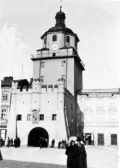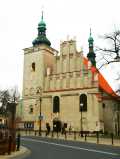Lublin Gothic Trail
 The Holy Trinity
Chapel at the Lublin Castle was founded in the 13th
c. by King Casimir the Great. This is a two-storey building of red
brick, with one nave on a rectangular plan, the presbytery with the
pentagonal top, and windows of an ogive shape. Inside, the ribbed
stellar vault is supported on one octagonal pillar (similar solutions
were adopted in other churches founded by Casimir the Great, e.g. in
Wiślica). The vault and the walls are covered with Russo-Byzantine
frescoes founded by King Ladislaus Jagiello and completed on 10
August 1418. The external architecture of the chapel has later,
Renaissance features: the triangular, plastered gable decorated with
semicircular panels, volutes and pinnacles, as well as the
semicircular frame of the window which used to be the entrance to the
Chapel.
The Holy Trinity
Chapel at the Lublin Castle was founded in the 13th
c. by King Casimir the Great. This is a two-storey building of red
brick, with one nave on a rectangular plan, the presbytery with the
pentagonal top, and windows of an ogive shape. Inside, the ribbed
stellar vault is supported on one octagonal pillar (similar solutions
were adopted in other churches founded by Casimir the Great, e.g. in
Wiślica). The vault and the walls are covered with Russo-Byzantine
frescoes founded by King Ladislaus Jagiello and completed on 10
August 1418. The external architecture of the chapel has later,
Renaissance features: the triangular, plastered gable decorated with
semicircular panels, volutes and pinnacles, as well as the
semicircular frame of the window which used to be the entrance to the
Chapel.
 The Cracow Gate was erected along with the town’s
fortified walls after 1341. The oldest, prism-shaped Gothic part of
the Gate was built of brick in the chequered pattern. The corners
were strengthened with stone blocks. In the 16th
c. the foregate was added, topped with crenellation and corner
turrets. The Gothic outline of the Gate was altered with the
octagonal, plastered top and the Baroque cupola complemented with the
monogram of King Stanislaus Augustus Poniatowski from the time of the
last remodelling of the Gate.
The Cracow Gate was erected along with the town’s
fortified walls after 1341. The oldest, prism-shaped Gothic part of
the Gate was built of brick in the chequered pattern. The corners
were strengthened with stone blocks. In the 16th
c. the foregate was added, topped with crenellation and corner
turrets. The Gothic outline of the Gate was altered with the
octagonal, plastered top and the Baroque cupola complemented with the
monogram of King Stanislaus Augustus Poniatowski from the time of the
last remodelling of the Gate.

The former Brigittine Church of Virgin Mary the Victorious (commonly known as post-Visitationist church) in Narutowicza Street No. 8 also has Gothic origins. The church was erected in the years 1412-1426. Unfortunately, due to numerous alternations, raising of the ground level around the church, and plastering of the whole building, the characteristic Gothic slenderness of the temple was lost. Some Gothic features can be traced in the buttressed walls, in the vertical pattern of the gable’s decoration, and in the stone portal hidden behind the belfry. Inside, in the attic, there are polychromes from the time of King Casimir Jagiellon, created between 1466 and 1477, which show a retinue, most probably of King Ladislaus Jagiello (the founder of the church), heading towards Lublin.
